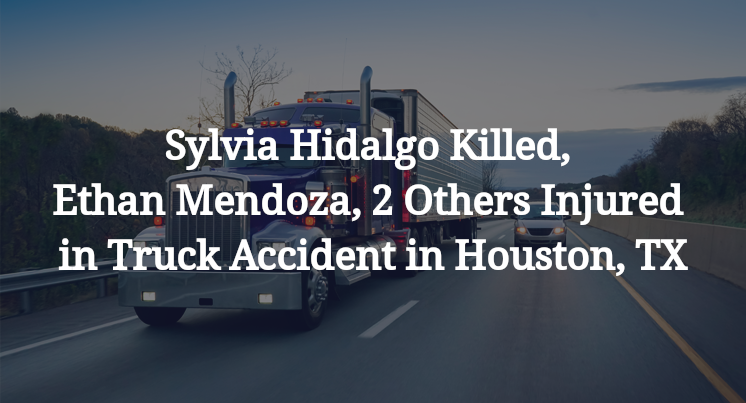Sylvia Hidalgo Killed, Ethan Mendoza, 2 Others Injured in Truck Accident in Houston, TX
Update (September 2, 2025): The driver of a 2021 Kia K5 involved in the accident has been identified as Ethan Mendoza, 20. He suffered minor injuries in the crash, according to a preliminary crash report.
Update (May 28, 2025): Authorities have identified the woman who was killed in this accident as Sylvia Jane Hidalgo, 53.
Houston, TX — May 26, 2025, one person was killed and three others were injured in a multi-vehicle accident at about 9:20 p.m. on Interstate 10/East Freeway.
Authorities said a semi-truck crashed into the back of an SUV that was stopped because there was a disabled car in front of it near Waco Street. The impact knocked the SUV into the disabled car, and it was hit by another vehicle after it veered onto the shoulder. The SUV burst into flames after the crash.

The woman who had been driving the SUV died at the scene of the crash, according to authorities. Her name has not been made public at this time.
The other three drivers involved in the crash were hospitalized with unspecified injuries, authorities said.
Authorities have not released any additional information about the crash on eastbound I-10. The accident is still under investigation.
Commentary
When people hear about a crash like the one on Houston’s East Freeway, their first reaction is often disbelief: How does a semi-truck slam into stopped traffic with such force that a vehicle bursts into flames? But the bigger issue, the one that needs real answers, is why it happened and whether it could have been prevented.
One of the key unanswered questions is why the truck driver didn’t stop in time. The SUV was reportedly stopped due to a disabled car in front of it. That creates a chain of events where everything hinges on whether the trucker was keeping a proper lookout. Was the driver distracted? Fatigued? Speeding? Was the trucker even aware of the traffic situation ahead?
These aren’t just hypotheticals. They’re questions that can be answered, if the right evidence is preserved and examined. Cell phone records can show whether the driver was texting or on a call. Dash cameras, if present, could reveal whether the driver saw the SUV at all. And the truck’s engine control module (or “black box”) might tell us how fast the truck was going and whether the brakes were applied before impact.
Of course, the truck driver may not be the only one whose actions, or inactions, played a role. Trucking companies are responsible for the drivers they put on the road. That means asking: Did they properly train the driver? Did they have systems in place to catch dangerous habits like speeding or distracted driving? Were they pushing drivers to meet unrealistic delivery times?
I’ve handled cases where a truck driver caused a fatal wreck, but the deeper issue turned out to be the company’s hiring practices. One company I sued hired a driver with multiple terminations on his record, someone who had no business behind the wheel of a big rig. In that case, the driver’s actions were only part of the story. The company’s negligence was just as critical.
We also don’t yet know if a mechanical failure contributed to the crash. That’s another reason why it’s essential to inspect the truck before it’s repaired or destroyed. Problems with brakes, tires or even trailer lights can turn a truck into a 40-ton hazard. If the crash was caused by a preventable defect, that points to a failure in maintenance, something the trucking company is also responsible for.
Another unanswered question is why the SUV caught fire. That’s not something that happens in every crash. Depending on how the vehicles collided and where the fuel systems were located, it could raise further questions about vehicle design or whether hazardous cargo played a role.
Key Takeaways
- We don’t yet know why the truck driver failed to stop, but the evidence needed to answer that — ECM data, dash cams, phone records — should be preserved immediately.
- It’s not just about the driver; the trucking company’s hiring, training and oversight practices must be scrutinized.
- A full inspection of the truck is needed to rule out mechanical failures that might have contributed to the crash.
- The post-crash fire raises additional questions about the impact dynamics and vehicle safety.
- Thorough investigation, not assumptions, is the only path to real accountability in a crash like this.

“These are essential reads for anyone dealing with the aftermath of a truck wreck”– Attorney Cory Carlson